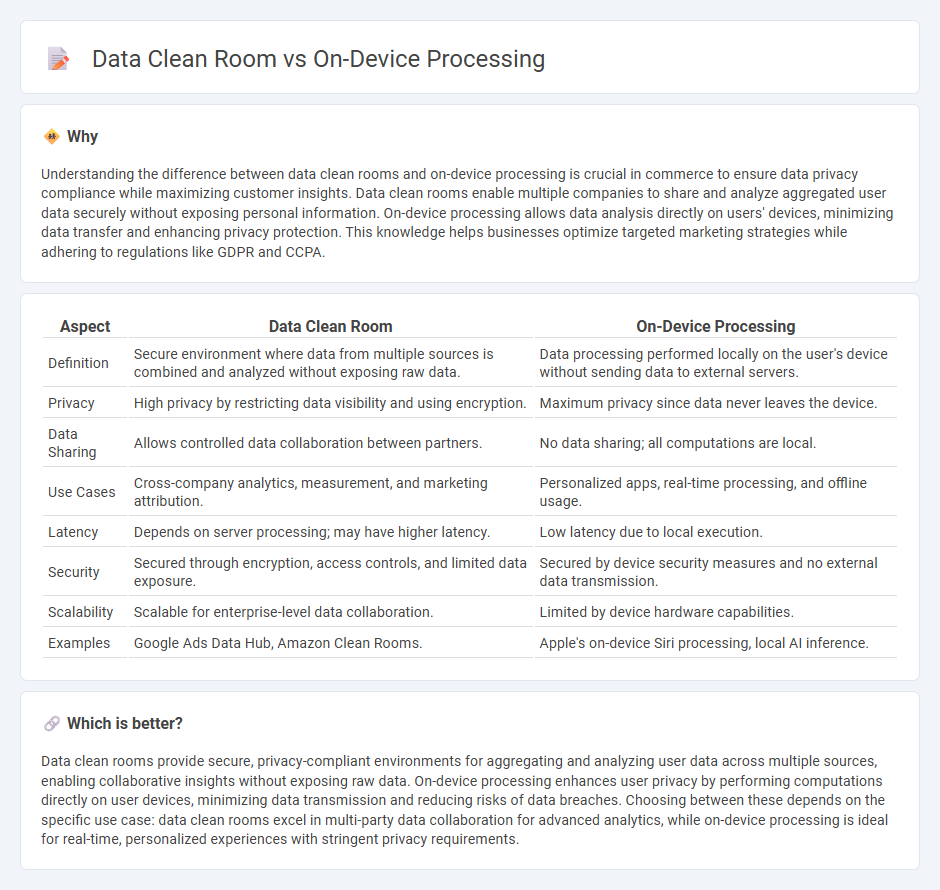
Data clean rooms enable multiple parties to securely share and analyze aggregated customer data without exposing personally identifiable information, driving precise targeting and measurement in commerce. On-device processing allows real-time data analysis directly on a user's device, enhancing privacy and reducing latency in personalized experiences. Explore how these technologies transform privacy-safe data collaboration and customer engagement in modern commerce.
Why it is important
Understanding the difference between data clean rooms and on-device processing is crucial in commerce to ensure data privacy compliance while maximizing customer insights. Data clean rooms enable multiple companies to share and analyze aggregated user data securely without exposing personal information. On-device processing allows data analysis directly on users' devices, minimizing data transfer and enhancing privacy protection. This knowledge helps businesses optimize targeted marketing strategies while adhering to regulations like GDPR and CCPA.
Comparison Table
| Aspect | Data Clean Room | On-Device Processing |
|---|---|---|
| Definition | Secure environment where data from multiple sources is combined and analyzed without exposing raw data. | Data processing performed locally on the user's device without sending data to external servers. |
| Privacy | High privacy by restricting data visibility and using encryption. | Maximum privacy since data never leaves the device. |
| Data Sharing | Allows controlled data collaboration between partners. | No data sharing; all computations are local. |
| Use Cases | Cross-company analytics, measurement, and marketing attribution. | Personalized apps, real-time processing, and offline usage. |
| Latency | Depends on server processing; may have higher latency. | Low latency due to local execution. |
| Security | Secured through encryption, access controls, and limited data exposure. | Secured by device security measures and no external data transmission. |
| Scalability | Scalable for enterprise-level data collaboration. | Limited by device hardware capabilities. |
| Examples | Google Ads Data Hub, Amazon Clean Rooms. | Apple's on-device Siri processing, local AI inference. |
Which is better?
Data clean rooms provide secure, privacy-compliant environments for aggregating and analyzing user data across multiple sources, enabling collaborative insights without exposing raw data. On-device processing enhances user privacy by performing computations directly on user devices, minimizing data transmission and reducing risks of data breaches. Choosing between these depends on the specific use case: data clean rooms excel in multi-party data collaboration for advanced analytics, while on-device processing is ideal for real-time, personalized experiences with stringent privacy requirements.
Connection
Data clean rooms enable secure collaboration by allowing multiple parties to analyze combined datasets without sharing raw data, enhancing privacy compliance in commerce. On-Device Processing complements this by performing data analysis directly on consumer devices, reducing data exposure risks and enabling real-time personalization. Together, these technologies optimize data security and accuracy in targeted advertising and customer insights within the commercial ecosystem.
Key Terms
Data Privacy
On-device processing enhances data privacy by keeping user information directly on personal devices, minimizing data transfer to external servers and reducing exposure to potential breaches. Data clean rooms protect user privacy by allowing multiple parties to analyze aggregated, anonymized data sets without exposing raw user data, ensuring compliance with privacy regulations such as GDPR and CCPA. Explore how these privacy-centric technologies can transform your data strategy and safeguard sensitive information.
Edge Computing
On-device processing enables real-time data analysis directly on edge devices, minimizing latency and enhancing user privacy by limiting data transmission to central servers. Data clean rooms aggregate anonymous user data from multiple sources in a secure environment to facilitate privacy-compliant analytics without exposing raw data. Explore the advantages of edge computing for secure, efficient data management and learn how it compares with data clean rooms.
Secure Data Collaboration
On-device processing enhances data security by analyzing information directly on user devices, minimizing data transfer risks and preserving privacy through decentralized computation. Data clean rooms provide a controlled environment for multiple parties to collaborate securely on aggregated datasets without exposing raw data, ensuring compliance with privacy regulations like GDPR and CCPA. Explore the benefits and applications of secure data collaboration by understanding the distinctions between on-device processing and data clean room technologies.
Source and External Links
Ask a Techspert: What is on-device processing? - On-device processing enables devices like smartphones to perform tasks locally without sending data to the cloud by using powerful chipsets such as Tensor G4, making AI tasks faster and more privacy-friendly.
On-device artificial intelligence | European Data Protection - On-device AI executes AI models directly on end devices like smartphones or wearables, minimizing latency and data transmission while enabling real-time decisions and enhanced privacy through local data processing and federated learning.
Privacy - Features - Apple integrates on-device processing deeply in its devices using specialized hardware like the Apple Neural Engine to ensure user data stays local and private, resorting to secure Private Cloud Compute only if additional processing power is needed, all with strict privacy protections.
 dowidth.com
dowidth.com